|
HISTORY 900 YEARS
1130 - 1487
The house has a long history, lovingly recounted by Philip Morant in his History of Essex, published in 1763-68. Morant gives Henry I's reign (1110-55) as the starting point. Sir Baldwin Wiscart was the first recorded Lord of the Manor. From his son John it passed to the knightly family of Bibbesworth, who lived here for four generations. Sir Walter de Bibbesworth was a crusader and a poet (in French).
The last Bibbesworth daughter to inherit the estate was married to a Thos. Catys from Warwickshire. It descended to her son and grandson before the line died out in 1486, having passed nearly three centuries at Saling. Nothing remains of the first Saling Hall, except (perhaps) the bottom of an ancient brick arch in the exceptionally spacious cellars.
1487 - 1665
In 1487 another long association started when the widow of John Maxey bought the Hall. Morant relates the details of six generations of Maxeys between the reigns of Henry VII and Charles II, when the last Maxey, Anthony, sold the property. It was the Maxeys who built the present house in its basic form: a plastered timber building - as it still remains around the courtyard on the north side - probably about 1590.
1665 - 1717
In 1665 Anthony Maxey sold Saling Hall to Martin Carter, a lawyer from nearby Shalford, for £3,980. His son, also Martin and also a lawyer (of Christ's College, Cambridge, and Lincoln's Inn) was described by Morant as 'an accomplished gentleman, and of singular learning'. In 1680 he faced the south, east and west fronts with red and blue bricks and added leaded window panes. He made 'great alterations and improvements to the house and gardens' in 1698, the date engraved on the bricks of the Walled Garden, and to the house the following year (as recorded on the east gable end).
Carter was of a conservative bent, it seems. The Dutch gables with which he ornamented and formalised his new facade are the latest example of their kind in the county by as much as twenty years.
|
|
 |
Carter also rearranged the inside of the house in such a way as to make the Elizabethan original almost indecipherable today. On the west (Walled Garden) side you can see changes of pattern in the brickwork which are clues to his building: a straight seam, where the Dutch gable wing has been added, and a bricked-up window, where he put his staircase ornamented with vase turned and twisted balusters.
Since Carter's time the house has changed little, and not at all in its essential, practical, comfortable design. The only modern alterations are the additions of the conservatory in 1980, and a single-storey room and long lead-roofed porch in the courtyard.
Eliza Maxey Carter
|
1717 - 1795
The Carters sold the house in 1717 to the Raymond family. Hugh Raymond was a man of substance, a sea-captain and shipbuilder in London who was involved in the spectacular financial crash known as the South Sea Bubble. He commanded an East Indiaman, the Duchess, and built the South Sea Company's ship Royal Prince. He became Colonel of the Tower Hamlets' Militia for the defence of London and had a house on Tower Hill. While in the East he commissioned an early example of Chinese armorial porcelain known as the Saling Service, of which several pieces survive. He was succeeded at Saling by his son Jones Raymond, who apparently installed the wine-cellar whose inventory (in 1768) is preserved in the Essex Record Office.
The Raymonds then sold the estate to William Evelyn in 1768. He leased it to Peter Burrell, who installed Mrs Amy Burrell in the house and she bought Saling Hall the following year. The house was then occupied by William Branch who was responsible for paying the church rate of £12.6.6. in 1789. Saling Hall was put up for auction in 1790 and the Hall was transferred to the estate of John Yeldham of Saling Grove beginning a connection between the two houses which was to last in one form or another into the twentieth century. Yeldham had built Saling Grove in 1750 and had commissioned Humphry Repton to lay out his park. Goodrich and his wife, Mary Wilson 'of New York', lived at the Grove from 1795.
1796 - 1829
In 1796 Mr Bartlett Goodrich bought both the major houses at Saling, the Hall and the Grove, formerly called Parks. Goodrich - hard as it is to imagine now - was an American who returned to England rather than live under the rebels - as he considered the first government of the United States. The Goodriches were one of the early Virginian families, settling in Nansemond, near Suffolk, in 1625. They had already, indeed, lived in America for 150 years at the time of the Declaration of Independence. Bartlett's brother, Bridger Goodrich, stayed on in Bermuda, where he commanded privateers against the Americans. According to his marble memorial in St Peter's Church, Bermuda, he was the terror of the Chesapeake Bay.
Two of his seven daughters had married sea captains: Captain William Dobbie and Captain (later Admiral) John Dick. Presumably to keep each other company during the long periods when their husbands were at sea (in Dobbie's case nineteen years in the East Indies), they lived together at the Hall, but divided it into two. It was thought that this was the reason for the two equally important front doors, but these were not added until 1840, when the house had multiple occupancy.
On Goodrich's death in 1824, his estate of 1600 acres, was put on the market, but the sale did not go smoothly and only Saling Grove was sold to William Fowke who began a major rebuilding of that house.
The Goodrich daughters remained in Saling Hall where Augusta Dick (nee Goodrich) died in 1829.
1833 - 1935
Saling Hall was put up for auction in 1833 by the executors of Bartlett Goodrich and was sold to William Fowke. John Dick and the Dobbies remained in Saling Hall until at least 1850, signing their names with a diamond on the window-panes.
In 1894 William Villiers Fowke moved in to Saling Hall as the owner, having sold Saling Grove to Captain Harrison, RN. By 1901 William Fowke had died and his widow Ellen and her family were living at the Hall. There is a record of her still living there in 1911 with 2 of her sons and a daughter and 4 servants.
Ellen Fowke died in 1914 and her son Villiers de Saussura Fowke remained in residence until 1919, when at the age of 74 he sold all of the Saling estate but retained the Hall and 18 acres, to be rented out. The last Lady of the Manor of this line was Anne-Maria Fowke,presumably Villiers' wife, who lived at the Hall around 1900.
Villiers rented the Hall to the farmer William Edward Duckworth, who in 1928 bought the house, only to sell it in 1935 when his wife Eva died.
|
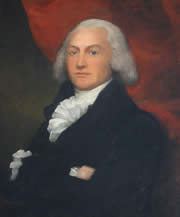
Bartlett Goodrich
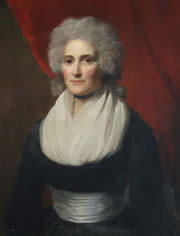
Mary Wilson "of New York"
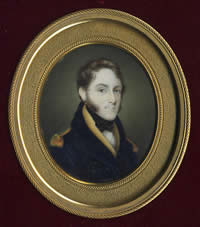 Captain William Dobbie Captain William Dobbie
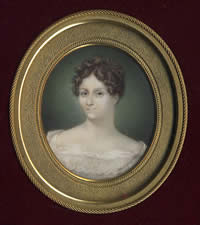 Agatha Dobbie Agatha Dobbie
|
1935 - 2013
In 1935 Saling Hall was bought by Isabella Carlyle, widow of Sir John Warrand Carlyle, a historian of political thought in medieval England and an Indian civil servant, who died in Florence in 1934. Lady Carlyle (née Barton) was a passionate gardener and gave Saling Hall its first modern gardens. She sold the Hall in 1971 to Hugh and Judy Johnson, dying in 1976 at the age of 101.
The Johnsons (Hugh Johnson is a well known writer of wine and gardening books) made considerable structural additions and internal alterations and continued the work of improving the gardens.
They sold Saling Hall in 2013 after living there for 42 years to Mark Faulkner and Harriet Logan and now the new owner's family will add to its heritage.
|
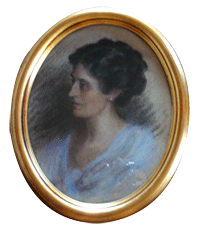 |
| |
Isabella Carlyle |
Despite its many nautical associations over two centuries, the name Saling - it is hardly necessary to add - has nothing whatsoever to do with messing about in boats. It is said to come from the Anglo-Saxon word for 'willow', from which we get 'sallow'.
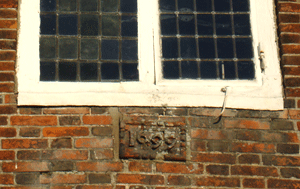 |
Saling Hall, then, has a long and quite well-documented history, has changed hands by sale only three or four times in 800 years, and has been altered little since its remodelling in 1699. |
|
| |
| |
| |
|
| |
| |
|